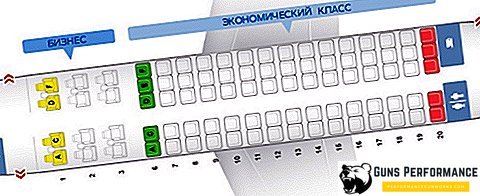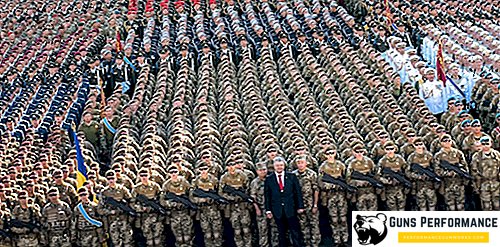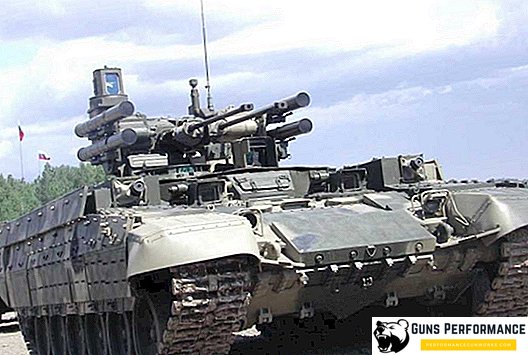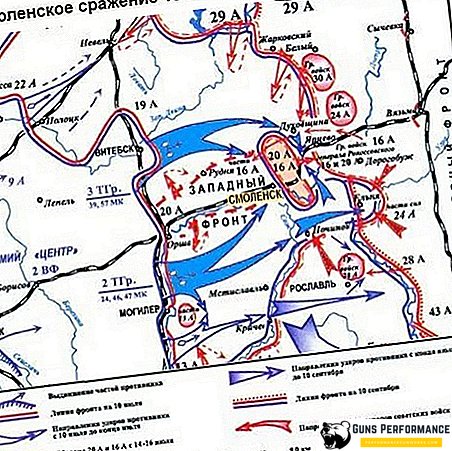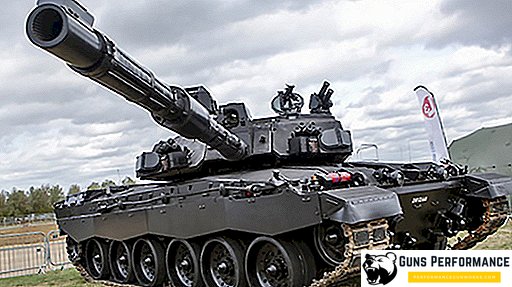
After the Nazis came to power, Germany began to restore its navy at an accelerated pace. For Hitler, owning a powerful fleet was not only a military matter, but also a political one. The return of the former power of Germany is the slogan with which the Nazis came to power, and the menacing battleships were a visible symbol of the power of the Third Reich.
In the mid-1930s, a secret program was adopted (the so-called Plan Z), according to which within ten years the German Navy was to receive a significant replenishment and become one of the strongest on the planet.
Until 1948, the Germans planned to launch eight battleships, four aircraft carriers, several heavy cruisers, more than a hundred destroyers and destroyers, as well as several hundred submarines of various types. The "highlight" of the program were to be two battleships "Bismarck" and "Tirpitz".
Plan Z could not be realized even by half (Germany simply didn’t have enough resources), but the battleships were still launched and became one of the most famous warships of their era. The history and death of the battleship "Bismarck" - one of the most interesting and exciting pages of the Second World War. The death of the battleship "Bismarck", one of the strongest ships of its class in history, marked the end of the era of powerful artillery ships without air support. It began the time of aircraft carriers.

History of creation
The battleship "Bismarck" was a continuation of the German "pocket battleships" that Germany was forced to build because of the restrictions imposed on it by the Versailles agreements.
In 1935, Germany unilaterally denounced the Versailles Agreement - no reaction from the victorious countries followed, no one wanted to fight with Hitler. Moreover, in the same year an Anglo-German agreement on maritime weapons was signed, which in fact recognized the new status quo.
At that time, Germany already possessed three battlecruisers (type "Deutschland"), in 1935 and 1936 the Scharnhorst and Gneisenau were lowered into the water, which the British gave the mocking nickname of "pocket battleships". Despite the very high combat qualities of all the above ships, they were noticeably inferior to their English counterparts. To achieve parity with the leading maritime powers of the time, the United States and Britain, the Germans needed to create something fundamentally new. Needed a breakthrough.
July 1 in Hamburg at the shipyard Blohm & Voss was laid a new German battleship, which was named in honor of Chancellor Otto von Bismarck, who united the country with "iron and blood." The battleship "Bismarck" was the first full-fledged ship of this class, created in Germany after the end of the First World War.

The Bismarck was conceived as an ocean raider, and it was ideal for such work. The battleship was launched on February 14, 1939, and German Chancellor Adolph Hitler and Bismarck’s Dorothea von Levenfeld’s granddaughter attended the ceremony and smashed a bottle of champagne on the ship’s keel. August 24, 1940 Ernst Lindeman was appointed as its commander.

During tests in the Baltic Sea, the battleship demonstrated a speed of more than 30 knots, which was one of the best indicators for similar ships in the world. The volume of the Bismarck fuel tanks corresponded to those of the Pacific battleships; the battleship could place six Ar 196 hydroplanes on board.
The ship was well armored, well armed, and the Bismarck’s fire control system at that time was considered one of the best in the world.
A few months later, a single-type Tirpitz was commissioned.
By this time, the world war was already raging, Germany controlled the territory of almost the whole of Europe, the main enemy of the German battleships was the English fleet. And here the situation for the steel giants of Hitler was very ambiguous. The Bismarck was superior to any English ship, but there were many more. By the beginning of 1941, there were fifteen dreadnoughts and battle cruisers in the British navy, several more were being built. Naturally, Bismarck could not count on an honest "knightly" duel, such a situation could arise only as a result of the error of the British command.

The German military leadership planned to use the Bismarck and Tirpitz as raiders, that is, they were to hunt for caravans of Allied transport ships. Both the power reserve and the speed of the battleships allowed them to perform similar tasks.
Military experts and historians are still arguing about the advisability of such tactics using battleships. On the one hand, submarines along with aviation could effectively destroy transports, but on the other hand, the entire British fleet put the communications of such a powerful warship as the Bismarck on its ears.
To counter this threat, the British had to expend enormous resources, which many times outweighed the damage that the battleship could cause in open battle. The only campaign "Bismarck" and the later few raids "Tirpitz" - a clear confirmation of this.
Be that as it may, on May 18, 1941, the battleship Bismarck, accompanied by the heavy cruiser Prince Eugen, sailed to the open sea.
Description of construction and technical characteristics

As mentioned above, the Bismarck became the first high-grade ship of this class in the German Navy after World War II. Moreover, during its short service, this ship was the largest battleship in the world. Battleships of this type are in third place in terms of their size, behind only the Japanese Yamato and the American Iowa.
Bismarck had a standard displacement of 41.7 thousand tons and a full displacement of 50.9 thousand tons. The battleship was notable for extremely powerful armor: the main armor belt covered 70% of the ship's length and had a thickness of armor from 170 to 320 mm. The frontal armor of the main-caliber gun turrets was even larger - 360 mm, and the armor belt was protected by a thickness from 220 to 350 mm.
No less serious was the armament of the Bismarck: eight 380-mm main-caliber guns, twelve 150-caliber auxiliary guns and a large amount of anti-aircraft artillery. Each tower of the main caliber had its own name: feed - Caesar and Dora, nasal - Anton and Brune. Despite the fact that the main caliber of the British and American ships at that time was somewhat larger (406 mm), the Bismarck’s 380-mm guns were a formidable force for any battleship.
Gorgeous training of German gunners, a perfect fire control system, good gunpowder and excellent quality sighting devices allowed the battleship to confidently penetrate the 350-mm armor at a distance of 20 km.
The power plant of the ship consisted of twelve steam boilers of the Wagner system and three turbo-gear units. Its total capacity was more than 150 thousand liters. p., which allowed the "Bismarck" to reach speeds of more than 30 knots. What can certainly be called an outstanding achievement of the German shipbuilders.
The range of the ship with an economical course exceeded 8.5 thousand nautical miles. The crew numbered more than 2.2 thousand sailors and officers.
The story of the last campaign "Bismarck"
On May 18, 1941, Operation Rhine Doctrine, which included the Bismarck and the heavy cruiser Prince Eugen, was launched into the Atlantic. Their main task was to work on British communications. German admirals assumed that while Bismarck would connect the ships of the convoy’s defense, Prince Eugen would be able to get close to the transports.
The operation was commanded by Admiral Günter Lütens, he asked for additional forces, but he was denied this.
Already on May 20, the British became aware of the appearance of two large German ships in the North Sea. A few days later they were photographed by an English reconnaissance aircraft, after which the British already knew exactly who they would encounter.
Home Fleet Commander Admiral Tovey sent a whole flotilla of several dozen pennants to search for and destroy two German ships. Its main strike force was the battle cruiser "Hood" and the battleship "Prince of Wales". Light cruisers and aircraft were attracted to search for the Bismarck. On May 22, Admiral Tovey, at the head of a whole compound of ships, went hunting for the Bismarck.
On May 23, in the Danish Strait, the British managed to establish visual contact with German ships, and the next day the Hood and the Prince of Wales opened fire on the enemy. Began a historic battle in the Danish Gulf.
The Germans did not respond for a long time, as they had a clear order to open fire only on the ships of the enemy convoys. However, they were soon forced to do so. The first hits managed to achieve the commanders of "Prince Ogeyna": several of its 203-mm shells hit the "Hood". The English artillery fire did not have much success.

About 6 o'clock in the morning "Bismarck" covered the "Hood" with a volley of the main caliber. It is likely that one of the German 380-mm shells broke through the rather thin armor deck of the English battleship and caused the detonation of its ammunition. A monstrous explosion tore up the Hood almost in half, out of 1,415 crew members only three survived.
Following the second issue of the "Prince of Wales", he was forced to maneuver in order to circumvent the wreckage of the sinking flagship, and thus he was substituted for the fire of two German ships at once. After receiving seven hits, the "Prince of Wales" came out of the fight, hiding behind a smoke screen.
It was a really impressive win: in just eight minutes, Britain’s strongest pennant went to the seabed. However, the Bismarck was damaged: two fuel tanks were pierced, and a boiler room No. 2 began to be poured over a hole below the waterline. The Bismarck received a trim on the nose and a roll on the starboard side, due to which the battleship's speed dropped significantly. 3 thousand tons of fuel oil flowed out of the damaged fuel tanks into the sea. Admiral Lyutyens decided to break through to the French port of Saint-Nazaire for repairs.
The loss of Hud, one of the best ships of the royal fleet, was a real shock for the British; now the destruction of the Bismarck has become a matter of honor for British sailors.
Already on May 24, the Bismarck was attacked by torpedo bombers, who achieved one hit in the main armored corps. He did not cause much harm, but during the maneuvering patches were torn off, and part of the battleship compartments finally flooded.
The British threw all the available forces to intercept the Bismarck, but because of the mistake of Admiral Tovey, they set off to look for a battleship off the coast of Norway. It would seem that now only a miracle can stop the German breakthrough to Brest. And it happened. This miracle was all the same Biplanes torpedo bombs "Sordfish", with an open cockpit and fuselage, covered with canvas. English pilots called these aircraft "wallets."

Armed 730-kg torpedo, very low-speed, "Suordfish" went on the attack so low over water that the German anti-aircraft gunners could not direct their guns at them. One of the torpedoes hit the target, it could not cause serious harm to the huge ship, but the Germans were unlucky again. The torpedo hit the rudder blade, leaving him without control. Now the "Bismarck" could not avoid meeting with the main forces of the English fleet, and he was doomed.
On the morning of May 27, the Bismarck was attacked by the British battleship King George V, Rodney and a group of heavy cruisers. The German Dreadnought could only make a turn at 8 knots, it almost lost its ability to maneuver, and the roll did not allow aimed fire. "Bismarck", in fact, turned into an ideal target. At 9 am, the main ranging post was destroyed, and a little later the 16-inch shell exploded in the control post, killing almost all the officers of the ship.
Within an hour, the Bismarck's main-caliber towers were destroyed, and the battle finally turned into a beating. The British fired on the battleship of 2800 shells of various calibers, having achieved more than seven hundred hits. "Bismarck" turned into burning ruins and only miraculously kept on the water. However, he did not want to give up.
After that, the British recalled the battleships and ordered the cruisers to destroy the ship with torpedoes. But after three torpedo hits, “Bismarck” did not go under water.
The fate of Captain Lindemann is still unclear. He is considered dead after hitting a 406-mm projectile in the bridge, but there are witnesses who claim that the captain until the end led the battle and voluntarily remained on the sinking ship.
At 10.39 "Bismarck" turned over with a keel and went under water. Until the last moment, a battle flag developed over it. Part of the crew clambered over the ship's hull and went with him under the water, with their arms raised in greeting.

Underwater expedition directed by James Cameron showed that the enemy fire only damaged the "Bismarck", but it was submerged by its own crew, who was not going to surrender to the enemy.
The English admiral Tovey, who led the hunt for the Bismarck, after his drowning, wrote in his memoirs that the German battleship had given the most heroic battle in very unfortunate conditions and went to the bottom with a proudly raised flag. The admiralty forbade Tovi to voice such thoughts in public.




